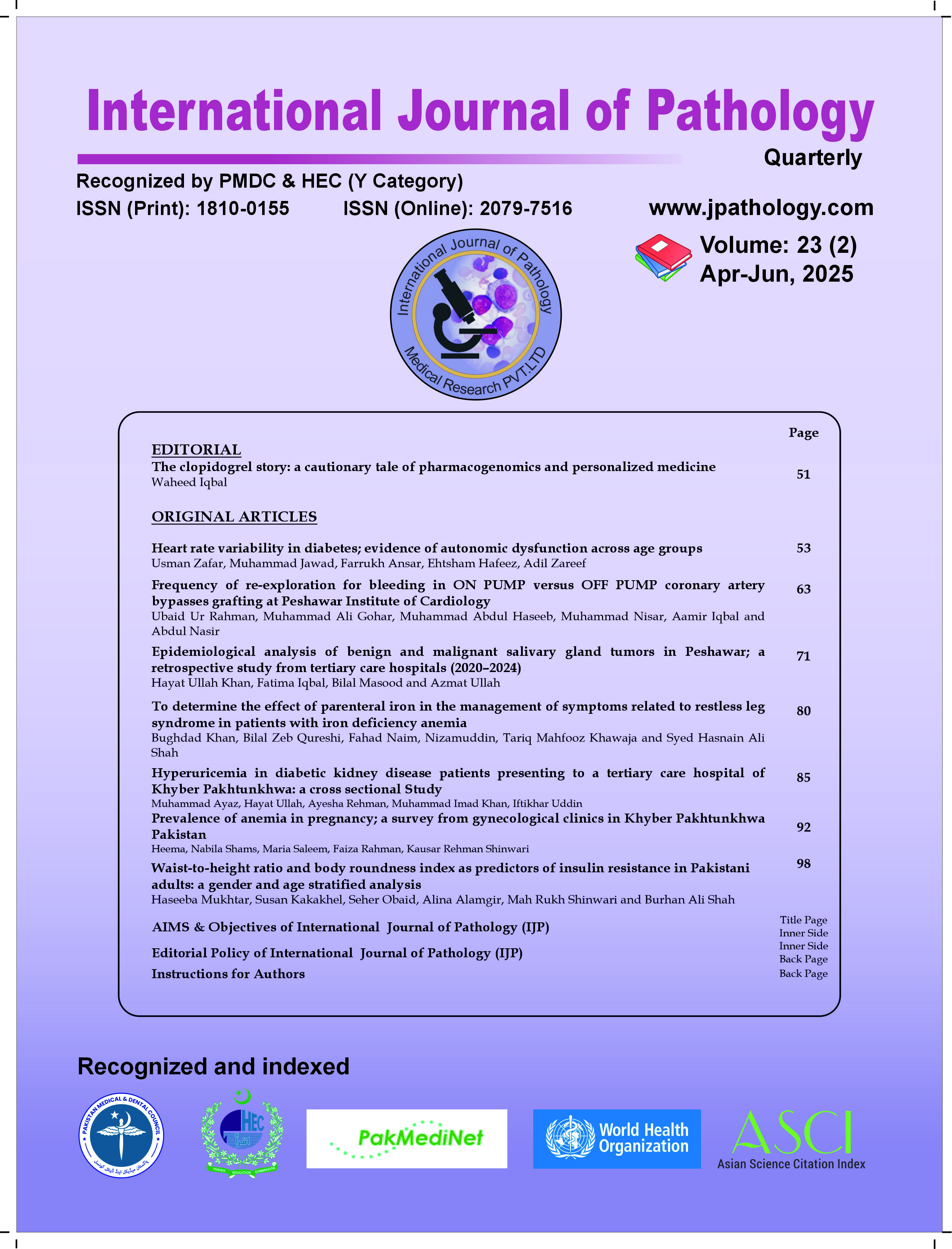To determine the effect of parenteral iron in the management of symptoms related to restless leg syndrome in patients with iron deficiency anemia
DOI:
https://doi.org/10.59736/IJP.23.02.952Keywords:
Hemoglobin, Iron Carboxymaltose, Iron Deficiency Anemia, Iron Deficiency, Restless Leg SyndromeAbstract
Background: The current study aimed to determine the frequency of restless leg syndrome (RLS) in patients with iron deficiency anemia (IDA) presenting to Khyber Teaching Hospital (KTH) and Khushal Medical Center (KMC) Peshawar and to see the effect of parenteral iron therapy on RLS with IDA.
Methods: This prospective cohort study enrolled 110 patients of either gender with IDA from September 2022 to December 2023. All patients were interviewed and data was recorded for restless leg syndrome as per operational definition. The diagnosed RLS patients were given 500mg iron carboxymaltose in 100ml normal saline (NS) over a period of 15 minutes stats and 500mg after two weeks and treatment response was assessed four weeks after the treatment. Clinical symptoms including pain, fatigue and sleep quality were recorded before and after the iron therapy. All the data were analyzed using SPSS version 22.0.
Results: RLS was observed in 35.5% patients with IDA. The mean age was 48.70±8.0 years. Male gender was 54.5% while female gender was 45.5% in our study. The levels of hemoglobin (Hb) were significantly improved with iron carboxymaltose (p-value <0.001). The symptoms related to RLS including pain, fatigue and quality of sleep were 90.1% improved after iron therapy. T-test reveals significant improvement in pain, fatigue and sleep quality before and after iron therapy with p-value <0.001. There was no statistical significant association between gender and improvement of symptoms related to RLS (p-value >0.05).
Conclusion: RLS was highly prevalent in patients with IDA in our population. Management of IDA with parenteral iron carboxymaltose not only improves the levels of Hb but provide immediate relief of symptoms related to RLS.
References
Wawer AA, Jennings A, Fairweather-Tait SJ. Iron status in the elderly: a review of recent evidence. Mech Ageing Dev. 2018 Jan; 175:55–73.
Trenkwalder C, Allen R, Högl B, Clemens S, Patton S, Schormair B, et al. Comorbidities, treatment, and pathophysiology in restless legs syndrome. Lancet Neurol. 2018 Nov;17(11):994–1005.
Padula WV, Phelps CE, Moran D, Earley C. Allocating provider resources to diagnose and treat restless legs syndrome: a cost-utility analysis. Sleep Med. 2017 Sep; 38:44–9.
Wijemanne S, Ondo W. Restless legs syndrome: clinical features, diagnosis and a practical approach to management. Pract Neurol. 2017 Dec; 17(6):444–52.
Earley CJ, Jones BC, Ferré S. Brain-iron deficiency models of restless legs syndrome. Exp Neurol. 2022 Feb; 356:114158.
Khan FH, Ahlberg CD, Chow CA, Shah DR, Koo BB. Iron, dopamine, genetics, and hormones in the pathophysiology of restless legs syndrome. J Neurol. 2017 Sep; 264:1634–41.
Allen R. Dopamine and iron in the pathophysiology of restless legs syndrome (RLS). Sleep Med. 2004 Jul; 5(4):385–91.
Nordlander NB. Therapy in restless legs. Acta Med Scand. 1953; 145(6):455–7.
Allen RP, Auerbach S, Bahrain H, Auerbach M, Earley CJ. The prevalence and impact of restless legs syndrome on patients with iron deficiency anemia. Am J Hematol. 2013 Apr; 88(4):261–4.
Bae H, Kim KT, Heo MH, Do YR, Cho YW. The prevalence and clinical characteristics of restless legs syndrome in patients with iron deficiency anemia in Korea. J Clin Sleep Med. 2021 Jul 1; 17(7):1447–52.
Allen RP, Picchietti D, Hening WA, Trenkwalder C, Walters AS, Montplaisi J. Restless legs syndrome: diagnostic criteria, special considerations, and epidemiology: a report from the restless legs syndrome diagnosis and epidemiology workshop at the National Institutes of Health. Sleep Med. 2003 Mar;4(2):101–19.
Rognoni C, Venturini S, Meregaglia M, Marmifero M, Tarricone R. Efficacy and safety of ferric carboxymaltose and other formulations in iron-deficient patients: a systematic review and network meta-analysis of randomised controlled trials. Clin Drug Investig. 2016 Feb; 36:177–94.
Koduru P, Abraham BP. The role of ferric carboxymaltose in the treatment of iron deficiency anemia in patients with gastrointestinal disease. Ther Adv Gastroenterol. 2016 Jan; 9(1):76–85.
Avni T, Reich S, Lev N, Gafter-Gvili A. Iron supplementation for restless legs syndrome: a systematic review and meta-analysis. Eur J Intern Med. 2019 Mar; 63:34–41.
Bae H, Cho YW, Kim KT, Li X, Earley CJ. Ferric carboxymaltose effects on restless legs syndrome and on brain iron in patients with iron deficiency anemia. Sleep Med. 2023 Feb; 109:128–31.
Downloads
Published
Issue
Section
License
Copyright (c) 2025 Bughdad Khan, Bilal Zeb Qureshi, Fahad Naim, Nizamuddin Utmani, Tariq Mahfooz Khawaja, Syed Hasnain Ali Shah

This work is licensed under a Creative Commons Attribution-NonCommercial 4.0 International License.
Readers may “Share-copy and redistribute the material in any medium or format” and “Adapt-remix, transform, and build upon the material”. The readers must give appropriate credit to the source of the material and indicate if changes were made to the material. Readers may not use the material for commercial purpose. The readers may not apply legal terms or technological measures that legally restrict others from doing anything the license permits.


